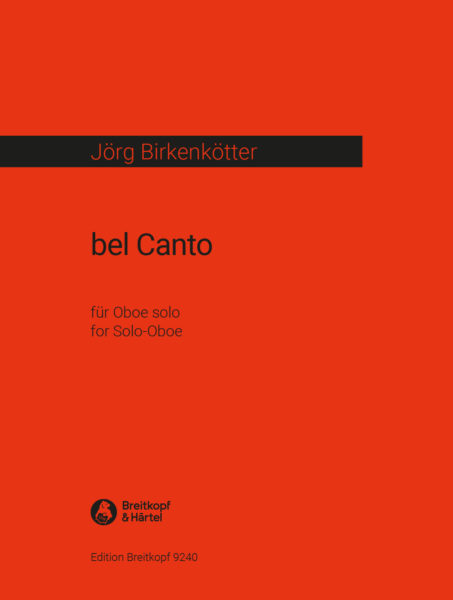Jörg Birkenkötter (*1963) bel Canto
für Oboe solo [Ob] 2013/14 Dauer: 13'30"
16 Seiten | 23 x 30,5 cm | 89 g | ISMN: 979-0-004-18540-7 | geheftet
Mit Belcanto wird die italienische Gesangskunst bezeichnet, die vom reich verzierten Sologesang des beginnenden 17. Jahrhunderts („novile maniera di cantare“) sich entwickelnd, bis in die erste Hälfte des 19. Jahrhunderts hinein bestimmend für den europäischen Operngesang war. Zur vollkommenen Beherrschung der Stimme gehörten neben legato und Messa di voce auch Appogiaturen und Portamenti sowie die virtuose Ausschmückung durch Koloraturen („canto fiorito“). Die Entwicklung zu höchster, an instrumentale Spielpraktiken angelehnte Virtuosität führte einerseits zu einem manieriert-artifiziellen Stil, betonte andererseits aber auch die individuelle interpretatorische Körperlichkeit (als Idealtyp des Belcantosängers galten die Kastraten). Und heute? Roland Barthes schreibt in seinem Aufsatz „Die Rauheit der Stimme“: „Die Rauheit ist der Körper in der singenden Stimme, in der schreibenden Hand, im ausführenden Körperteil.“ Er bezieht dies zunächst auf die Reibung zwischen Sprache und Stimme im Gesang, überträgt seine Gedanken dann aber auch auf die Körperlichkeit von instrumentaler Musik.
In diesem Sinne habe ich nach einem „schönen Gesang“ gesucht, einer Schönheit, die vielleicht gerade dort entstehen kann, wo das Raue, d. h. auch die körperlichen Widerstände, nicht eingeebnet werden.
Die Oboe schien mir sehr geeignet, mit solchem „Körperausdruck“ zu singen, ist sie doch ein sehr schönes, aber auch ziemlich widerspenstiges Instrument!
Das Rückgrat meines Stückes ist eine einzige, quasi unendliche Melodielinie, bestehend aus sich permanent auseinanderziehenden und wieder verengenden Intervallen (atmend). An diesen Tönen lagern sich die verschiedensten Aktionen an: Koloraturen, Triller, Akkorde (multiphonics), Doppelflageoletts. Aber nicht nur Klangtypen, sondern auch Impulse, Repetitionen, rhythmische Figuren und anderes: auskomponierte Belcanto-Elemente.
In der beschriebenen Operntradition waren dies improvisierte Verzierungen/Zusätze, hier werden sie zu komponierten Gestalten, die von den Melodietönen ausgehen, aber auch an ihnen zerren, sie verbiegen, „mit Körper aufladen“.
(Jörg Birkenkötter)










 Blättern
Blättern